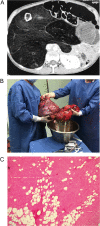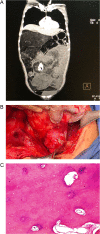Massive retroperitoneal dedifferentiated liposarcoma in a young patient
- PMID: 30310651
- PMCID: PMC6174626
- DOI: 10.1093/jscr/rjy272
Massive retroperitoneal dedifferentiated liposarcoma in a young patient
Abstract
Liposarcomas are rare malignant tumors that mostly develop in the retroperitoneum. They have a broad behavioral spectrum, from small masses of tissue to highly aggressive tumors. The dedifferentiation process occurs in up to 10% and it's most likely to occur in the retroperitoneum, a process that not only changes its components but also its prognosis. These tumors can grow to a massive size since most of them do not give any symptoms until they invade the adjacent structures. Timely detection and surgery could avoid all these potentially lethal scenarios. We present a case of a 34-year-old patient, who reported a growing mass in her abdomen that reached massive proportions but remained untreated due to lack of sufficient access to healthcare facilities in her geographic location. After complete removal of the mass the patient underwent complete recovery, dedifferentiated liposarcoma was the final diagnosis.
Figures



References
-
- Thway K, Jones R, Noujaim J, Zaidi S, Miah A, Fisher C. Dedifferentiated liposarcoma. Adv Anat Pathol 2016;23:30–40. - PubMed
-
- Vijay A, Ram L. Retroperitoneal liposarcoma. Am J Clin Oncol 2015;38:213–9. - PubMed
-
- Binh M, Guillou L, Hostein I, Château M, Collin F, Aurias A, et al. . Dedifferentiated liposarcomas with divergent myosarcomatous differentiation developed in the internal trunk. Am J Surg Pathol 2007;31:1557–66. - PubMed
Publication types
LinkOut - more resources
Full Text Sources

